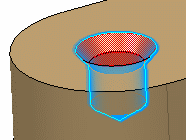Creating a Hole | ||||||||
|
| |||||||
Select the circular edge and upper face as shown.
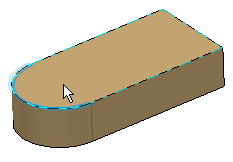
The application can now define one distance constraint to position the hole to be created. The hole will be concentric to the circular edge. The Hole Definition dialog box appears and the application previews the hole to be created. The Sketcher grid is displayed to help you create the hole.
Important: Clicking Sketcher  opens the Sketcher. You can then constrain the point
defining the hole position. Once you have quit the Sketcher,
the Hole Definition dialog box reappears
to let you define the hole feature.
opens the Sketcher. You can then constrain the point
defining the hole position. Once you have quit the Sketcher,
the Hole Definition dialog box reappears
to let you define the hole feature. 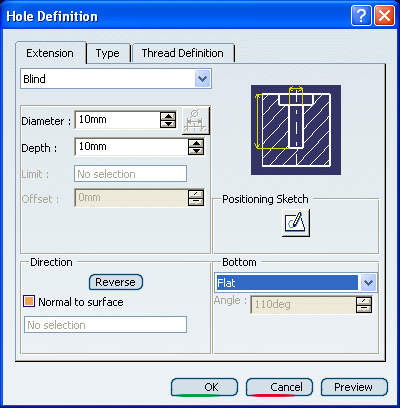
Now, define the hole you want to create. By default, the application previews a blind hole whose diameter is 10mm and depth 10mm. Enter 24mm as the diameter value and 25mm as the depth value.
Keep Normal to surface to define the direction. By default, the application creates the hole normal to the sketch face. But you can also define a creation direction not normal to the face by clearing the Normal to surface check box and selecting an edge or a line.
Tip: Contextual commands creating the directions you need are available from the Direction box: If you create any of these elements, the application then displays the line or the plane icon in front of the Direction box. Clicking this icon enables you to edit the element. - Create Line: For more information, see Generative Shape Design User's Guide: Creating Wireframe Geometry: Creating Lines.
- Create Plane: See Generative Shape Design User's Guide: Creating Wireframe Geometry: Creating Planes.
- X Axis: The X axis of the current coordinate system origin (0,0,0) becomes the direction.
- Y Axis: The Y axis of the current coordinate system origin (0,0,0) becomes the direction.
- Z Axis: The Z axis of the current coordinate system origin (0,0,0) becomes the direction.
If you create any of these elements, the application then displays the line or the plane icon in front of the Direction box. Clicking this icon enables you to edit the element.
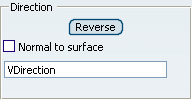
Set the Bottom option to V-Bottom to create a pointed hole and enter 110 in the Angle box to define the bottom shape.
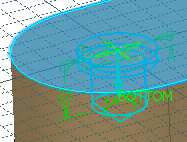
Select Countersunk in the the Type tab.
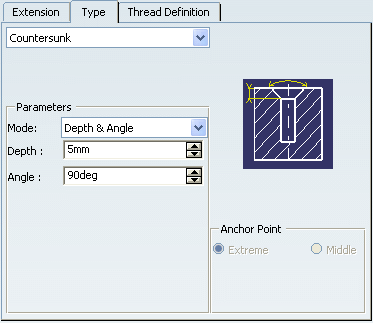
To create such a hole you need to choose two parameters among the following options:
- Depth & Angle
- Depth & Diameter
- Angle & Diameter
Select the Angle & Diameter parameters in the Mode box.
Tip: You will notice that the image in the dialog box assists you in defining the desired hole. 
Enter 80 degrees in the Angle box.
The preview lets you see the new angle.
Enter 35mm in the Diameter box.
The preview lets you see the new diameter.
Click OK.
The hole is created. The specification tree indicates this creation.
Note that the sketch used to create the hole also appears under the hole's name. This sketch consists of the point at the center of the hole.
Hole.X is added to the specification tree in the Solid FunctionalSet.X node.
